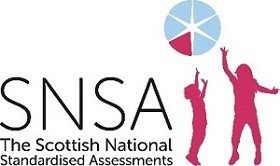SNSA Newsletter – November 2021
 Welcome to the SNSA newsletter
Welcome to the SNSA newsletter
This SNSA newsletter is full of information and advice to help you with the SNSA.
Overview of SNSA long scale
The SNSA long scale is a single quantitative national scale for each curricular area, used to present the progression in skills and concepts acquired as children and young people advance from Primary 1 to S3. This allows professionals to assess and gauge a learner’s progress over time. The long scale for each learning area is divided into bands and describes progression in the skills, knowledge and understanding typical for learners in that year group, based on the actual questions from the assessment. The descriptions are aligned with the standards embedded within Curriculum for Excellence, demonstrated in the experiences and outcomes.
You can find detailed information on each of the learning areas by clicking on the links below:
• SNSA numeracy long scale
• SNSA reading long scale
• SNSA writing long scale
 Updates to Training
Updates to Training
The training homepage has been redesigned to help teachers identify courses. Visit the training page for more information.
Course 1, Course 1 for P1 and Course 2 video modules have also been updated for the 2021-22 academic year and can be accessed here.
Learner name on log in screen
When a learner logs in to their SNSA account they’ll see their name on the screen. Check with your learners to ensure they can see their own name as this will confirm that they’ve logged in correctly and should prevent any of your learners from accidentally sitting an assessment on the wrong account. You may prefer all your learners to have the same password, allowing them to log-in to the SNSA system with ease with their unique username. This could be especially useful for teachers who may be logging in for their learners. Go to Prepare for the Assessment – Password guidelines for information on changing your learners’ passwords.
 Download the pre-assessment checklist
Download the pre-assessment checklist
SNSA pre-assessment checklists contain essential information and good practice advice on how to administer SNSA in the classroom. The checklists will help you prepare if you are new to SNSA. These are now available in a convenient downloadable format.
Tips from the SNSA service desk team
Access SNSA data from previous years
Primary school staff can view SNSA data from 2020-21 SNSA cohort or previous years if the learners are still enrolled at their school. Primary school staff who require access to SNSA data for last year’s P7 learners (now in S1) should contact their local authority, or the new school. Secondary school staff can view the SNSA data for last year’s P7 cohort who are now in S1 in their school.
In addition, the Outcomes by Academic Year (OBAY) report shows outcomes for all learners at each stage and curricular area, according to their year of presentation. More information about the OBAY report is contained within SNSA Course 6 (recorded webinar), available in the training materials on the help pages.
Confirmation message functionality
The feature alerts teachers when assigning an assessment to a child or young person which does not match their year level. The alert allows teachers to either continue with the assignment or go back and change their assessment selection.
This new feature has been developed to help practitioners ensure that the appropriate stage assessment is assigned before the child or young person undertakes the assessment.
Contact the service desk
The SNSA service desk is available from 8am to 6pm Monday to Friday ready to answer any questions you may have. Kelly, Scot, Andrew and Hazel would be delighted to hear from you. You can contact the team on 0330 403 0041 or email: servicedesk@snsa.org.uk
